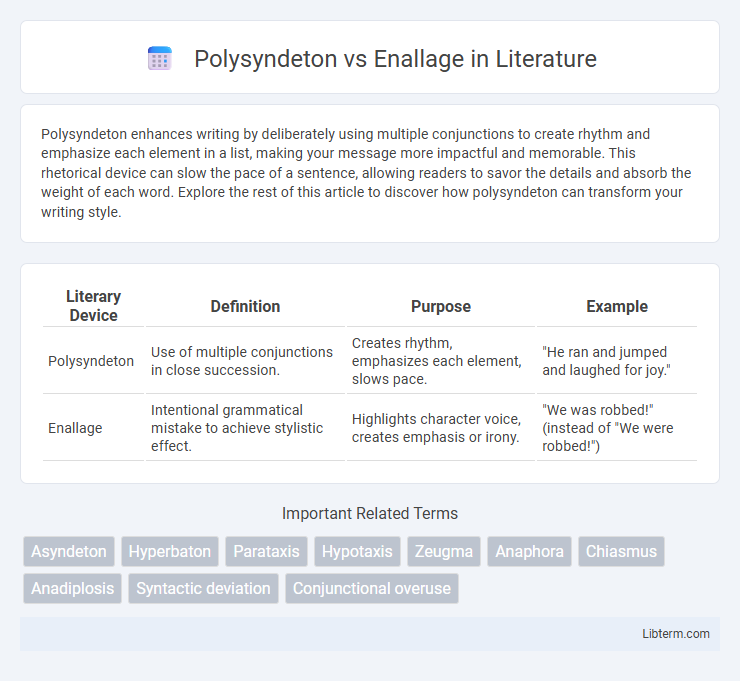Polysyndeton enhances writing by deliberately using multiple conjunctions to create rhythm and emphasize each element in a list, making your message more impactful and memorable. This rhetorical device can slow the pace of a sentence, allowing readers to savor the details and absorb the weight of each word. Explore the rest of this article to discover how polysyndeton can transform your writing style.
Table of Comparison
| Literary Device | Definition | Purpose | Example |
|---|---|---|---|
| Polysyndeton | Use of multiple conjunctions in close succession. | Creates rhythm, emphasizes each element, slows pace. | "He ran and jumped and laughed for joy." |
| Enallage | Intentional grammatical mistake to achieve stylistic effect. | Highlights character voice, creates emphasis or irony. | "We was robbed!" (instead of "We were robbed!") |
Introduction to Polysyndeton and Enallage
Polysyndeton is a rhetorical device characterized by the repeated use of conjunctions in close succession to create a deliberate, rhythmic effect or to emphasize each element in a list. Enallage involves the intentional alteration of grammar, such as verb tense or pronoun usage, to convey a particular stylistic nuance or to reflect a character's voice. Both devices enhance linguistic expressiveness by manipulating syntax, thereby enriching the texture and persuasiveness of prose or poetry.
Defining Polysyndeton
Polysyndeton is a rhetorical device characterized by the deliberate repetition of conjunctions in close succession, often to create a sense of rhythm, emphasis, or overwhelm. It differs from enallage, which involves the intentional grammatical substitution of one form for another to achieve a stylistic effect. Polysyndeton can be found in literary works and speeches where the excess conjunctions slow down the pace, adding weight to each item in a list or series.
Understanding Enallage
Enallage is a rhetorical device involving the deliberate substitution of one grammatical form for another, such as changing verb tense, voice, or person, to create emphasis or convey a particular tone. Unlike polysyndeton, which involves the repetition of conjunctions to slow rhythm or add intensity, enallage manipulates syntax to enhance expressiveness or character voice. Mastering enallage deepens understanding of stylistic variation and enriches textual interpretation by highlighting subtle shifts in language use.
Historical Origins of Both Devices
Polysyndeton, a rhetorical device characterized by the repeated use of conjunctions, traces back to ancient Greek and Latin literature, prominently utilized by classical authors such as Homer and Cicero to create rhythm and emphasize continuity. Enallage, the intentional substitution of one grammatical form for another, also finds its roots in classical antiquity, employed by poets like Virgil and rhetorical figures to enhance expression and stylistic effect. Both devices emerged from the rich traditions of classical rhetoric, serving distinct purposes in shaping persuasive and poetic language throughout history.
Key Differences Between Polysyndeton and Enallage
Polysyndeton is a rhetorical device involving the deliberate use of multiple conjunctions between clauses or words to create emphasis or rhythm, such as "and" repeated in a list. Enallage, on the other hand, is a figure of speech involving intentional grammatical or syntactical mistakes, like shifting tense or person for stylistic effect. The key difference lies in polysyndeton's focus on conjunction repetition for emphasis, whereas enallage centers on altering standard grammar to achieve expressiveness or variation.
Effects on Tone and Rhythm
Polysyndeton, characterized by the deliberate use of multiple conjunctions, creates a rhythmic cadence that slows down the pace and emphasizes each element, contributing to a tone of abundance or intensity. Enallage, involving the intentional substitution of grammatical forms, can shift the tone by adding informality, urgency, or a poetic quality, affecting the natural rhythm through unexpected syntactic deviation. Together, these devices manipulate sentence flow and tone, enhancing emotional impact and stylistic nuance in writing.
Usage in Classical and Modern Literature
Polysyndeton is frequently employed in classical literature to create rhythm and emphasize each element in a series, often found in epics like Homer's Iliad to intensify narrative pace. Enallage, a deliberate grammatical shift such as altered verb tense or pronoun mismatch, appears in both classical and modern texts to convey character voice or highlight thematic contrasts, seen in Shakespeare's plays and contemporary poetry. Modern literature tends to use polysyndeton for stylistic effect in prose and dialogue, while enallage remains prevalent in experimental writing and poetic forms to challenge traditional syntax.
Examples of Polysyndeton in Sentences
Polysyndeton involves the deliberate use of multiple conjunctions in close succession, such as in the sentence "She bought bread and milk and cheese and eggs." This literary device emphasizes each item or idea, creating a rhythmic and cumulative effect. Examples include sentences like "He ran and jumped and laughed for joy," where the repeated "and" highlights the intensity or multitude of actions.
Examples of Enallage in Sentences
Enallage involves the intentional misuse of grammar to create a rhetorical effect, such as shifting verb tense or changing pronoun cases within a sentence, enhancing emphasis or tone. Examples of enallage include the phrase "We was robbed" where singular verb tense is used with a plural subject, or "You is my friend," altering subject-verb agreement for stylistic impact. Unlike polysyndeton, which adds multiple conjunctions to slow rhythm or build intensity, enallage manipulates grammatical forms for emphasis or character voice.
Choosing Between Polysyndeton and Enallage in Writing
Choosing between polysyndeton and enallage depends on the desired stylistic effect and clarity in writing. Polysyndeton employs multiple conjunctions to create a deliberate rhythm and emphasize each element, enhancing emotional intensity or detail. Enallage, a grammatical shift, alters standard syntax or word forms to generate emphasis or character voice, making it more suitable for stylistic variation or dialogue representation.
Polysyndeton Infographic

 libterm.com
libterm.com